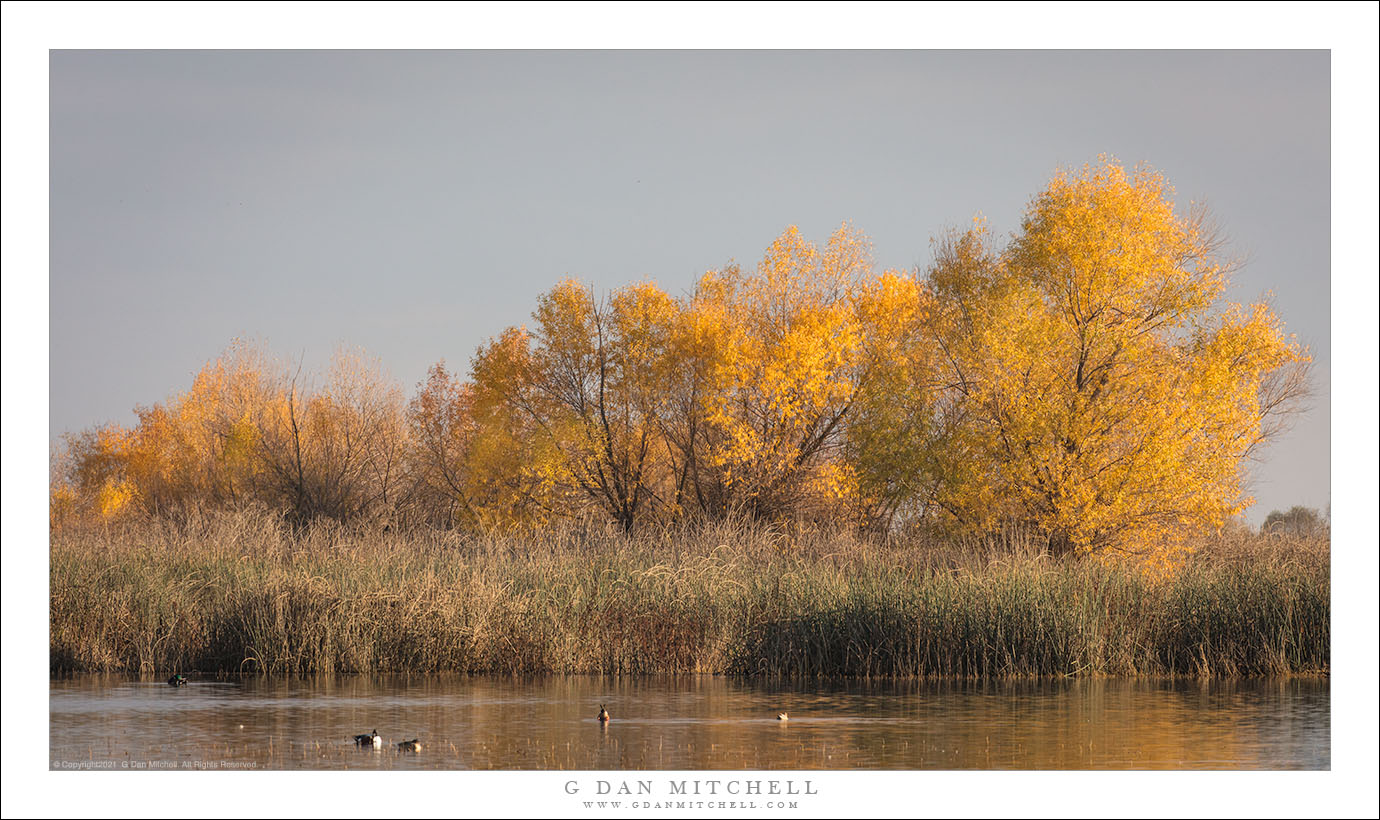
Wetland Trees, Late Autumn. © Copyright 2021 G Dan Mitchell – all rights reserved.
A row of trees with fall color, Central Valley wetlands.
If there is more beautiful light than muted late-autumn sun on colorful trees against a slightly darkened sky, I’m not sure that I’ve ever seen it. It was a foggy day in the Central Valley of California during this brief season between the heat of summer and early autumn and the cold and often gray winter. For a few weeks there is a surprising amount of autumn color out here, though it took me quite a long time to understand this.
Just when is autumn, anyway? I know that the calendar tells me it begins on the late-September autumnal equinox and that it ends on the December winter solstice, but that’s not quite what it feels like. I used to think that it was when the Eastern Sierra aspens change color, roughly during the first weeks of October. But years ago I began to tune in to subtle changes in the Sierra that clearly said “autumn is coming” as early as August. By September corn lilies, bilberry, and willows show color, but in the lowlands it is still effectively summer. In the Great Valley and in the coastal areas closer to where I live, real fall color doesn’t arrive until November, and it lasts well into December. I have even photographed “fall color” in January of the new year!
G Dan Mitchell is a California photographer and visual opportunist. His book, “California’s Fall Color: A Photographer’s Guide to Autumn in the Sierra” is available from Heyday Books, Amazon, and directly from G Dan Mitchell.
Blog | About | Flickr | Facebook | Email
Links to Articles, Sales and Licensing, my Sierra Nevada Fall Color book, Contact Information.
Scroll down to leave a comment or question.
All media © Copyright G Dan Mitchell and others as indicated. Any use requires advance permission from G Dan Mitchell.
Discover more from G Dan Mitchell Photography
Subscribe to get the latest posts sent to your email.

I was going to begin my reply by acknowledging that this is a Sirius issue… ;-)
A bit of (very brief) looking around only convinces me that the term “dog days” has become quite fluid. At its most general it apparently refers to the whole period of summer with heat and so forth as “the dog days of summer.” Or maybe it refers to the hottest part of summer… which would be different in various locations. (An article I read today pointed to data about when the hottest summer days occur in different locations in the US. In my location it tends to be late in the season, but in other places it typically happens quite early. And then, just yesterday, I head/read someone reference… “the dog days of August!”
Dan
Good Morning! Yes there are all sorts of interpretations to the dog days and I do believe originally it was more towards the end of summer but with changes in the calendar over the years I think the modern interpretation is early July to mid August. Astronomically speaking I think Sirius doesn’t rise to coincide with any more, but it’s still kind of fun! Here in Houston it’s June through October LOL!
Here’s the quote from the article I mentioned. Unfortunately I believe that webpage is gone but thankfully I had copied it into a note. Here is the part about the light of August:
“August brings a change in the light of day. The changes are subtle, but they are there at midday and at dusk. You see the light changes most clearly in the early morning hours just after dawn arrives.
It is still the light of summer, but the shadows lie differently than they did a month ago. There is a feel and a look of gathering haze.
Sunset no longer has its June clarity, and leans more toward a brassy color. Rain-washed air is more dazzling than it was in July.
Each season has its own light. Spring dawn literally sparkles with clarity. During May the middays are tinged with a subtle green to match the color of the new leaves. Fall days are golden, reflecting the season’s haze. Winter’s light is frosted and silvered. Winter dawns and dusks are wrapped in shades of blue light and purple. The shadows of winter are long, regardless of the time of day. The light of July and August dazzle with heat. “
North American Wildlife Health Care Center was the name of the page.
Thanks for commenting!
That August change of light has always gotten my attention, even if it took me decades to put all the pieces together and realize what causes it, at least in part.
As for the Dog Days, I have always thought those were at the very end of summer…
Dan
Beautiful! According to the old farmers almanac the dog days ended today, so fall must be on the way! I found a beautiful essay online about the change of light in August. When I find it I’ll put it on this post if you allow links. Otherwise I’ll just copy and paste that paragraph . I know you’ll love it !